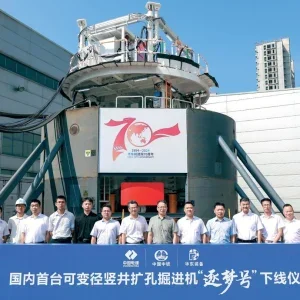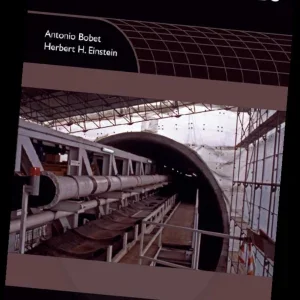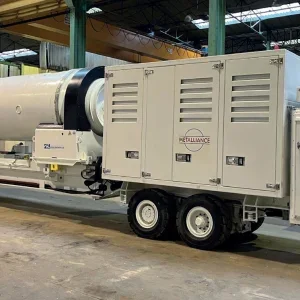In March 2021, Sylvia De Vuyst (pictured on the cover), freshly hired as a tunnel surveying manager for Mesta, a civil engineering construction company based in Lysaker, Norway, arrived at the northern extremities of Norway. She would be the lone surveyor responsible for a major tunnelling project, the US$24.8m renovation of the Maursund and Kågen Tunnels, two critical routes that connect the cities of Nordreisa on the mainland and Skjervøy on Kågen island.
Each around 2km long, the Maursund Tunnel runs under the North Sea, reaching a depth of 92.5m below sea level with a 10% grade in some areas; the Kågen passes through Kågen mountain, which is vulnerable to avalanches and landslides. Built in 1991, both structures will undergo extensive upgrades; this will include widening of carriageways, installing new LED lighting, CO/NO2 gas meters, new water and frost protection, and new drainage systems, not to mention the installation of new road surfaces. After one week in the dark, damp tunnels, one project requirement became abundantly clear to De Vuyst: she would need to be agile.
“A major challenge with the Maursund is that it needs to stay open 24/7 to allow traffic to pass through at set times,” she says. “This means that many times a day the diggers and bolt riggers need to move to the side, big trucks need to drive out and sometimes I need to stop my survey work. So, when we are clear to work, we have to maximise our productivity. To ensure construction stays on target and pace, I need to be efficient, reliable and precise.”
Instead of using the traditional total station – the typical domain of tunnel surveys – De Vuyst opted to replace convention with a scanning total station. Combining the high-accuracy total station point measurement with the speed and precision of 3D scanning, De Vuyst is managing two tunnel environments where tolerances are tight, space is at a premium, visibility is low and expectations are high – on her own. And she is matching the frenetic pace of the digging, blasting and bolting at six times the speed of multiple-person crews.
STAYING AGILE
Tunnel surveying is a specific breed of project activity that requires unique techniques and skillsets. It is challenging to create and manage a geodetic control network to operate in a Global Navigation Satellite System (GNSS)-restricted environment and also maintain high accuracy over a long distance underground. It also requires a solid understanding of geodesy to anticipate how the vertical alignment of the tunnel is affected over its length.
Not only do the Maursund and Kågen tunnels have these general complexities, they also have multiple layers of challenges in addition to the 24/7 traffic-flow issue. Neither one has been designed with a pre-defined shape, making it more difficult to guide construction. All the rock material that is extracted is immediately reused by other firms so there is no option to measure stocks and calculate volumes. None of the machinery – save one grader with a Trimble SCS900 – is equipped with machine control. And in the Maursund tunnel, a technical building, measuring 5.4m wide, 4m high and 19m long, needed to be constructed and assembled into a confined space with a tolerance of 0.5m.
When the renovation first began in January 2021, the original plan was to run a two-person survey team with a total station and occasional scanning, and they would alternate every week. However, given the scale, setting and project deadlines, this approach proved problematic within the first two months of work.
“Measuring and establishing control for the carriageway – one of the most essential jobs to ensure we create the required width and height – with a total station requires constant setting up, measuring and setting out, which is quite time consuming,” says De Vuyst. “So, in order to keep up, they had to be on site every day and night taking measurements. Laser scanning is far more efficient. With my scanning total station, I can scan 500m to measure control at a precision of 5mm in four hours; that would take the total station team two days. That efficiency has not only enabled me to manage all surveying tasks by myself, it has allowed me to limit my time on site to only four days every other week, saving us survey costs and positively impacting the project’s budget.”
The scanning total station that De Vuyst is referring to is the Trimble SX12, a total station and scanner combination that is particularly well suited to underground projects – such as tunnels. It can scan a full dome at 100m with a point density of 0.1m in 11 minutes, lock onto a prism in five seconds, and pinpoint a 3mm-diameter spot at 50m with its green, eye-safe laser pointer.
“We chose the SX12 based on extensive demos we received on it as well as our experience with previous Trimble SX models,” explains De Vuyst. “The combination of surveying and scanning technology makes it incredibly versatile – I can perform multiple functions from the same set up. It’s fast and precise which is important for such a dynamic environment. With its ease of use, short learning curve, simple and intuitive functionality and seamless workflow integration, I felt I would be in good hands with the total station for my first project with Mesta.” Based on progress to date, it seems the surveying tasks have been in good hands with De Vuyst.
SHEDDING LIGHT
As darkness is the one constant in the tunnels, it has been crucial for crews to have reliable reference points to know where they are physically in the tunnel and where specific work needs to be done. So, one of De Vuyst’s main tasks has been to seamlessly switch between the total station and scanner to provide that guidance. Using the instrument’s robotic total station, she has been establishing ground control by setting out prisms at 80m intervals along the tunnel walls. With those fixed points, De Vuyst maintains a project control network accurate to 5mm.
To guide the four teams of 40-50 people working in the tunnel easily and reliably, De Vuyst uses the scanning total station to establish and measure a ‘metre line’, a horizontal line sprayed every 10m that indicates the 1m-mark above the Maursund’s future new road.
“The existing road has steep grades descending down around 80m and it curves so it isn’t a reliable reference,” says De Vuyst. “We know the elevation and design of the new road so I can use that theoretical data and the scanning total station to measure and set out the metre line, which not only gives crews a physical position in the tunnel, it provides a marker to follow for determining their own work, such as laying cables or installing reinforcing materials on the walls. To lay that out with a traditional total station would require hours of multiple set ups but with the green laser range and speed of the SX12, I can capture the survey data in minutes from one position.”
VOLUMES OF VOLUMES
If there is one word that often dominates De Vuyst’s day, it is ‘volume’. With the routine blasting and digging to both widen and heighten the Maursund, De Vuyst is constantly checking and calculating volumes to confirm teams have removed enough material to create a 6m-wide carriageway with a 1.2m shoulder on each side and a clear height of 4.6m.
And she has had to be creative with machine control since none of the diggers on site are connected to universal total station (UTS) positioning technology. To resolve this, De Vuyst first created a 3D model of the tunnel’s ‘driving box’, the pre-defined height and width needed to allow vehicles to safely drive through. Scanning 60m sections of the tunnel, she imported the 3D data into special software to create a model of the road and then input the 6m wide and 4.6m-high driving box dimensions to produce a linear 3D drawing of the box. She imported it into special software and saved it as master file on a TSC7 controller, enabling her to quickly check earthworks progress any time by positioning the total station, measuring any point, and immediately identifying any underbreak in relation to the driving box perimeter visible on the controller’s graphical interface.
She has also been creating 3D ‘profile prints’, drawing files that provide the tunnel shape, tunnel bottom, driving box, and a numbered position marker for tunnel orientation. Once a section has been blasted or dug out, De Vuyst positions the total station and captures a fulldome scan to collect a georeferenced point cloud of the 60m area. She integrates that data into the software and using a tunnel module and its classification tool, she automatically cleans and processes the data to create a tunnel shape – a process that takes just three minutes per scan.
“The scanner captures everything it sees – people, cars, even water droplets – as well as the tunnel shape,” says De Vuyst. “Without the automatic classification tool in the software, I’d have to manually select each bit of noise and delete it. That feature, along with the automatically georeferenced scans, saves me hours of processing time. And because I know I can eliminate noise automatically; I don’t worry about passing traffic or objects in the way.”
Once she has the tunnel shape, she can combine survey controls with the density of points to calculate and verify earthwork volumes as well as convert the 3D model to a tunnel-profile drawing, indicating precisely where more soil needs to be removed and how much. Digger operators then use the prints in their cab as a machine control guide.
“I make profile prints of the tunnel at every half metre,” says De Vuyst. “That allows everyone to monitor progress at set intervals. Crews can not only see how the tunnel looks now, but I can also provide historical views to show how the tunnel looked a week ago or even at the beginning of construction. It’s incredibly helpful for measuring and monitoring progress.”
The ability to efficiently produce tunnel profiles was particularly beneficial for preparing and positioning Maursund’s technical building, which is located at the tunnel centre, 93m below sea level.
Teams needed to blast out a space 5m deep by 20m long. Precision was paramount because the building’s pre-fabricated construction was designed to be within only half a metre of the tunnel wall. De Vuyst used the SX12 to the ‘as-built’, and carefully calculated the excavation volumes based on two profile prints for the same area in order to ensure the space was correct. In early June, crews successfully constructed the technical building.
BRAVING THE BOLTS
In addition to checking and calculating volumes, De Vuyst has also been inundated with bolts – prism bolts, reinforcement bolts, lighting bolts and signage bolts, all of which she has either been taking ‘as-builts’ of or setting out.
Of the approximately 170 bolts she has set out, the most challenging to position accurately were the bolts for road signs that will be installed in the tunnel. The bolts needed to be set at a minimum height of 2.2m above the finished road but at the time, a ditch for underground cables had been dug, making access to properly mark the positions difficult. De Vuyst resolved this with the total station’s green laser and a truck with a hydraulic bed.
With a tunnel shape model as a base, she used the defined design plans and national height specifications to determine and draw set-out lines indicating where the bolts should be placed. She then imported that 3D file into the TSC7’s Access software. Setting up the total station about 20m from the truck, she used the set-out function and let the scanner’s green laser navigate to the corresponding line. From there she used the controller to move the laser along the line until it hit the precise break point. The person on the truck could then mark the tunnel ceiling at the exact bolt position.
“The clarity, precision and range of the green laser made the task so much easier,” says De Vuyst. “Even at 100 metres away, points are crystal clear.”
With one kilometre of the Maursund tunnel now complete with installed bolts, reinforcement materials, concrete fire protection, and 8.5bn 3D points, De Vuyst will continue to do more of the same for the last half of the Maursund and the full length of the Kågen to meet the completion deadline of autumn 2022. She still may not know what to expect as work continues, but she is confident the versatility of the total station/scanner will light the way.






